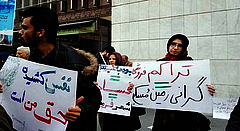Tehran is in Crisis
» Official from Iran’s Environmental Organization:
In an exclusive interview with Rooz, the director general of Iran’s Environmental Agency Mohammad Darvish spoke with Rooz about the demonstrations in front of the City Council against the municipality’s policy of selling its lands and converting green space into commercial zones. He believes the first action that needs to take place is addressing the capital’s environmental problems is to get rid of the racketeers and developers who buy real estate for the sole purpose of reselling them after building more buildings on them.
On Tuesday, January 27th, a group of Tehrani residents, students and environmentalist activists staged a protest in front of the City Council to protest the “destruction of the capital’s parks” and the municipality’s plans to sell licenses and space to builders. They chanted such slogans as “we are suffocating” and “land selling till when?” Some news agencies reported clashes during the demonstrations.
The protesting crowds, some of whom also carried other placards such as “What happens to the non-monetary budget of the municipality,” were directed by the city council’s security officers to the sidewalks across the municipality’s main building.
While the demonstrators demanded to see the mayor or city council members, only a midlevel official, the director general of the public relations office Shahram Gilabadi, came forward to speak with the protestors.
Speaking to a reporter, a protesting student explained the purpose of the gathering in these words, “The reason people are gathering here is because of the disregard for the environment and the green space in Tehran, and the daily growth in buildings and highway constructions. For this reason we are protesting the city council’s policies and particularly the growing number of land conversions in the city. We are not talking about political issues.”
Another protestor said, “It is interesting to see that some officials completely disregard these protests as if they are not related to the wrong policies in the management of the city. Neither the city council nor the municipality have shown any response to the protests.”
Yes another demonstrator spoke specifically of the destruction of green space in Tehran for the purpose of building high-rises in ward 5 of the city. Darvish was sympathetic to this and said, “Unfortunately large cities where the price of real estate is high embark on selling land for construction purposes as a way of raising their needed funds.” According to him, Tehran does not have the capacity to hold 10 million people because of its geo-natural conditions. “We should not facilitate the selling of lands for construction,” he said.
Unplanned Construction in the Capital
But what are the real issues of the city? Mohammad Darvish believes that the quality of air in the capital has fallen beyond acceptable standards. “In addition to the quality of the air, Tehran also suffers from falling availability of water. Desertification around the city is making inroads from the south-west, that is from the Ghazvin province, and also from the desert in the south-east, i.e., the towns of Moinabad and Varamin. The cause for the increase in the number of air pollutant particles are the unplanned constructions in Tehran,” he said.
200 Billion Minutes are Wasted by Tehranis Annually
Darvish explained what in his view is the cause of the city’s falling air and other essential qualities by saying, “As the population of the city is allowed to grow in this manner, the result is that there is an increase in the shops that build construction material, which in turn increases the production of pollutants and sulfur into the air. Under these conditions, traffic increases in the city and because of it the residents of the capital lose about two hundred billion minutes a year of their life wasted in traffic. This is a major economic loss by itself”, he said.
Water is another problem that Tehran has been grappling with for years. It has been reported that 12 large cities in the country suffer from a water shortage and that two major dams, Lar and Latian in the west of Tehran which provide the bulk of the capital’s water needs have already dried up. This problem is an addition to the deteriorating air quality and rising population issues.
Darvish described the gravity of the situation. “The western part of Tehran today suffers from a 17 meter fall in its underground water reservoir. The surface land in that part of the city drops by about 36 centimeters every year. All of these indicators point to the fact that Tehran is facing a crisis situation.” His solution is to put a moratorium on taking down any building in the city that is less than 60 years old in order to prevent profiteers and builders who aggressively search for places to build for the purposes of selling. “This is the first step that should be taken.”
“Unfortunately, when we look at the number of hospital beds, the number of cultural centers per capita, the number of recreational facilities per resident, sports complexes, universities, etc. in Tehran and compare them to other cities in the country, it is only natural for people outside the capital to want to come here.”



